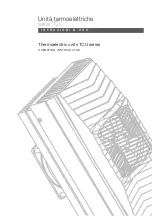
Rev 26.0/4-13
26
MRT4-DC: #35070
V
ACUUM
P
UMP
M
AINTENANCE
−
T
HOMAS
107CDC20
WARNING: Before proceeding with any maintenance, disconnect power source.
If the vacuum pump (14) takes too long to attain full vacuum, it may require maintenance.
Replace the diaphragm, valve flappers or head gasket as necessary to obtain acceptable pump
performance (see REPLACEMENT PARTS LIST).
Replacing the Diaphragm
1) Remove the four head screws (1) and remove the head (2).
2) Remove the four diaphragm hold-down screws (10) and the
diaphragm hold-down plate (12)
.
3) Replace the diaphragm (13) and reverse the steps above for
reassembly.
Replacing the Intake Valve Flapper
1) Remove the four head screws (1) and remove the head (2).
2) Remove the intake valve flapper screw (8) and the intake valve
keeper (7).
3) Replace the intake valve flapper (11) and reverse the steps above
for reassembly.
Replacing the Exhaust Valve Flapper and Head
Gasket
1) Remove the four head screws (1) and remove the head (2).
2) Invert the head and remove the four valve plate screws (9).
3) Lift out the valve plate (6) to access the exhaust valve flapper and
head gasket.
16
4) Remove the exhaust valve flapper screw (3) and the exhaust valve keeper (4), and replace
the exhaust valve flapper (5).
5) Replace the head gasket (15) and reverse the steps above for reassembly.
1 HEAD SCREWS
6 VALVE PLATE
11 INTAKE VALVE FLAPPER
2 HEAD
7 INTAKE VALVE KEEPER
12 DIAPHRAGM HOLD-DOWN PLATE
3 EXHAUST VALVE FLAPPER SCREW
8 INTAKE VALVE FLAPPER SCREW
13 DIAPHRAGM
4 EXHAUST VALVE KEEPER
9 VALVE PLATE SCREWS
14 VACUUM PUMP
5 EXHAUST VALVE FLAPPER
10 DIAPHRAGM HOLD-DOWN SCREWS
15 HEAD GASKET
16
CAUTION:
Depending on the product, the vacuum system may require the valve plate (6) to be rotated to an orientation
different from the one shown. When removing the valve plate, always take note of its orientation in the pump head (2), and
install the valve plate the same way during reassembly. In all cases, the valve plate must be oriented so that its intake hole is
matched with the head port that connects to the check valve.
Summary of Contents for MRT411LDC
Page 2: ......







































